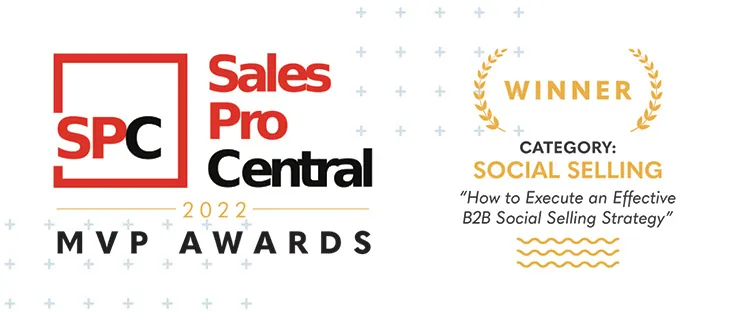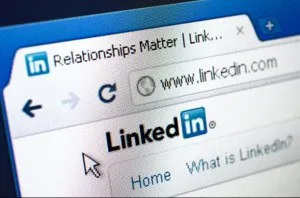How to Execute an Effective B2B Social Selling Strategy

Social Selling has never been more popular. We all know the Kardashians can sell their products directly to consumers on social media, but what are the best B2B sales organizations and their sales reps doing with social midway through 2022? That’s the question we wanted to answer. In this article we gather the most recent social selling statistics, break down what they mean to B2B sales reps, and explore what skills sales reps need to succeed post pandemic.
B2B Social Selling
The term “social selling” in the B2B sales process is misleading. Unlike business-to-consumer (B2C), where a shopper may view a cool new outfit on Instagram, click a link and complete the transaction all online, B2B social selling is not that simple. In B2B social selling, posting product information and linking to a demo sign-up page typically generates a conversion rate close to zero. New B2B sales reps quickly learn that sending a DM to prospects with their Calendly link to schedule a demo of the new “game-changing” solution is not a quota achieving strategy. In fact, if B2B social selling success is a skill-based exercise, requesting product demos on social media is not a sales skill needed for sales success.
At the most rudimental level, B2B social selling is using a social platform to access prospects’ contact information and initiate a cold outreach. For example, this is how many sales reps use LinkedIn Sales Navigator: They find the name and title of the decision maker at organizations they’d like to do business with and start the follow-up cadence as defined by the sales process. Social platforms are only a tool for sales reps and their organization, just like a hammer. Without skill, a hammer can be used for destruction. Alternatively, with the right skills, a hammer is a tool that can be used to build something more significant than you otherwise could with your bare hands.
B2B social selling has evolved from a data collection tool for outbound sales efforts into a trust-building platform for organizations and their sales reps. The best organizations are leveraging the content distribution capabilities of social platforms to attract interested prospects to their solution, as opposed to constantly promoting products. Traditional organizations view social selling as something sales reps can do on their own to prospect with potential clients. Trust Radius, a B2B research platform, found that 64% of B2B buyers listed cold calling as the number one reason they would be less likely to purchase from a vendor.
The Trend of Social Selling
Everyone in B2B knows that social selling is a thing. Sales reps have been using social selling for years. However, “social selling” as a search term recently peaked in October 2021 and has been hovering around the high for the last several months. But how popular is it? Google Trends is an online platform that shows you how popular a topic is over time. According to Google Trend data, social selling has never been more popular:

What does this mean for sales reps? First, everyone with a LinkedIn Sales Navigator account likely believes they are social selling. LinkedIn has over 830 million users and 39% subscribe to one of their premium services. I could not find statistics on Sales Navigator users specifically, but I did find LinkedIn revenue is over $8 Billion annually. This means the number of Sales Navigator users is likely over a couple million.
Why should a sales rep care how many sales reps are using Sales Navigator? Because the more sales reps that are using the tool at the most rudimentary level (contact info collecting), the less effective it is for pipeline building strategy. Need proof? Just ask any CEO, founder, or director-level executive how many unsolicited meeting requests they receive via Inmail daily. For sales reps and organizations that want to maximize the value of social selling, they have to advance past cold outreach and develop more sophisticated strategies.
B2B Social Selling Content
With the evolution of social selling, there are now two particular types of sales content. On the one hand, you have content that is optimized for Google’s algorithm to index search results. This type of content is often less effective for social selling. For social selling content to be effective, it must be personalized. B2B social selling content should not be created purely as content to generate traffic or leads (although LinkedIn reports 42% of social traffic to your website originates with them).
According to LinkedIn’s B2B Thought Leadership Report, “While consumption is up, satisfaction is not. The majority (71%) of decision-makers say that half or less than half of the thought-leadership content they read or watch gives them any sort of valuable insights.” B2B companies often struggle to humanize their social content, especially when their product offerings are technical and business oriented. What this means for sales reps and companies alike is that B2B content is not just created for content’s sake, but it needs justification and to serve a purpose.
Unique Opportunity for Sales Reps
If you sell B2B, the fact that 71% of decision-makers think the majority of content they consume provides little valuable insights should be good news. The key word is “insights.” Sales reps have a unique opportunity to share valuable insights with their prospects through social media.
For sales reps, insights mean sharing something your prospects did not know. This is the information they can’t find on Google because you learned it from first-hand experience working with real clients. As sales professionals, we work with a variety of clients and we have insights into the market, competition, financial performance, and other potential challenges clients are likely to face. When you’re thinking about insights, think about what would help your clients compete, not what your product or service does.
Social Selling Scoreboard
Measuring your social selling results is more than counting how many followers and likes you generate. As sales professionals, we want to validate that our social selling activities are generating a positive return on our efforts. Certainly, connecting (followers) and engaging (likes) provide quantitative data on your content’s performance.
However, measuring the impact on the salesforce’s performance requires a deeper dive into social analytics. LinkedIn provides a social selling index that measures individual social selling efforts. You can click here to receive your free score.
Sales leaders should also consider the following questions:
- What is the actual number of social media shares by the salesforce?
- How are sales reps using social media throughout the sales process?
- How much time are sales reps investing in social selling?
- To what extent is the salesforce (LinkedIn Pulse) to engage their audience?
- To what extent is the company using LinkedIn live?
Company management plays an important role in facilitating social selling among the sales force. It is very easy for sales reps to spend hours on social selling efforts, with very little to show for it. Instead, sales leadership should provide guidance and social selling best practices as part of the sales process. The goal is for sales reps to systematically (not randomly), share insightful content that engages with their target audience. Companies can motivate sales reps to use social selling by providing training and support. Instead of just telling sales reps what to do, sales leaders can provide directions on how to do it.
In most organizations, social selling is heavily relied upon by the individual sales rep. Companies that want to maximize the growing trend of social selling would be wise to help sales rep with content creation and technology tools to increase their efficiency. This includes having a document social selling strategy.
In Conclusion
Today, nearly everyone in B2B sales is using some form of social selling. What is clear is that most sales reps are using social selling for research and data collection. As sales reps, we certainly need to do our research and have current contact information, but that is a skill that can easily be outsourced and automated. For sales reps and companies to maximize their social selling results, they need to switch from social selling to social insight sharing. When prospective clients see that you have insights that can make them more competitive, profitable, or efficient in their industry or job performance, then buying will become a natural byproduct of social sharing.

- Account Planning (11)
- Awards (50)
- Client Testimonial (37)
- Personal Branding (19)
- Podcast (11)
- Research (68)
- Sales Career Development (85)
- Sales Coaching (153)
- Sales Consulting (133)
- Sales Culture (164)
- Sales Enablement (340)
- Sales Leadership (108)
- Sales Management (242)
- Sales Negotiation (16)
- Sales Prospecting (124)
- Sales Role-Playing (18)
- Sales Training (229)
- Selling Strategies (255)
- Soft Skills (67)
- Talent Management (92)
- Trusted Advisor (27)
- Virtual Selling (41)
- Webinar (10)






























